Having obtained a reasonably reliable 10MHz lab reference (see here) I decided to calibrate my Frequency Counter only to find that the stock oscillator provided in the HP 53151A is absolutely terrible – a joke even! I looked around for an “010 High Stability Timebase Option” but they are rare — and if you can find one not installed in a counter they are very expensive – in the few hundred dollars range at least — and buying one from HP is, well, expensive in the extreme. There are many second-hand 10MHz OCXO modules available, these are mostly stripped from old telecommunications, satellite or cellular equipment so they are plentiful and relatively cheap to buy too. I decided to make a clone 010 option board for my counter using a second-hand OCXO bought from e-bay. I designed a PCB to get a professional finish as well as a reliable upgrade for my counter. The main goal was to make an option board that just like the original could be automatically calibrated using the internal software and front panel controls so I had to use the same DAC chip (which is now obsolete) and basic topology of the original option board to make it work.
The result speaks for its self – with the OCXO running as the timebase, the counter is able to measure the 10MHz source it was calibrated with to a precision of 100th of one cycle with no error!
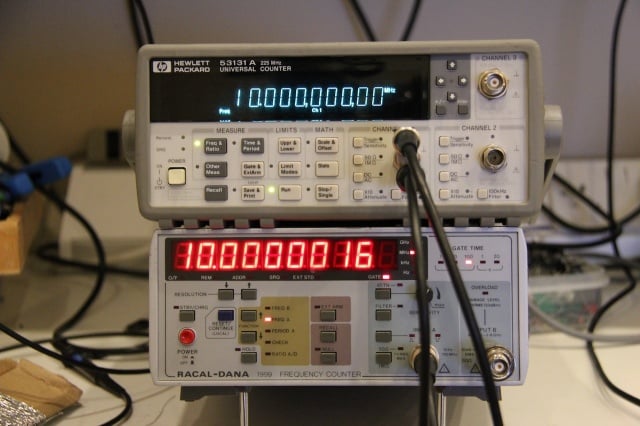
The schematic is pretty simple and self-explainatory. The counter seems to need a differential square wave clock drive, this is created using a high-speed differential output comparator part LM361. The DAC is an AD7243 part from Analog Devices, this part is now obsolete and not recommended for new designs but they are still available from various sources, albeit quite expensive parts. It would have been possible to design in a newer part but for the small number of units I wanted to make, it seemed a bit pointless to go to the effort as the recommended newer part actually requires different serial signaling, and this would have required some kind of serial protocol converter microcontroller. The DAC is driven by the counters microprocessor to calibrate and tune the timebase. The ADR4550 provides a high stability 5V reference for the ADC. The rest of the circuitry is basically power supply and signal filtering.
The PCB layout was designed to accommodate different OCXO footprints making it flexible. As well as supporting OCXO’s there are footprints for SMA connectors and you can even use a low-cost TCXO which cannot be automatically calibrated but is still a considerably better option than the oscillator built into the counter.
PCB’s Available : See here
The finished board fits really neatly inside the counter, and even fits around my previous Hard Power Switch Modification project.
Various Pictures
Catch you next time….
This content is published under the Attribution-Noncommercial-Share Alike 3.0 Unported license.
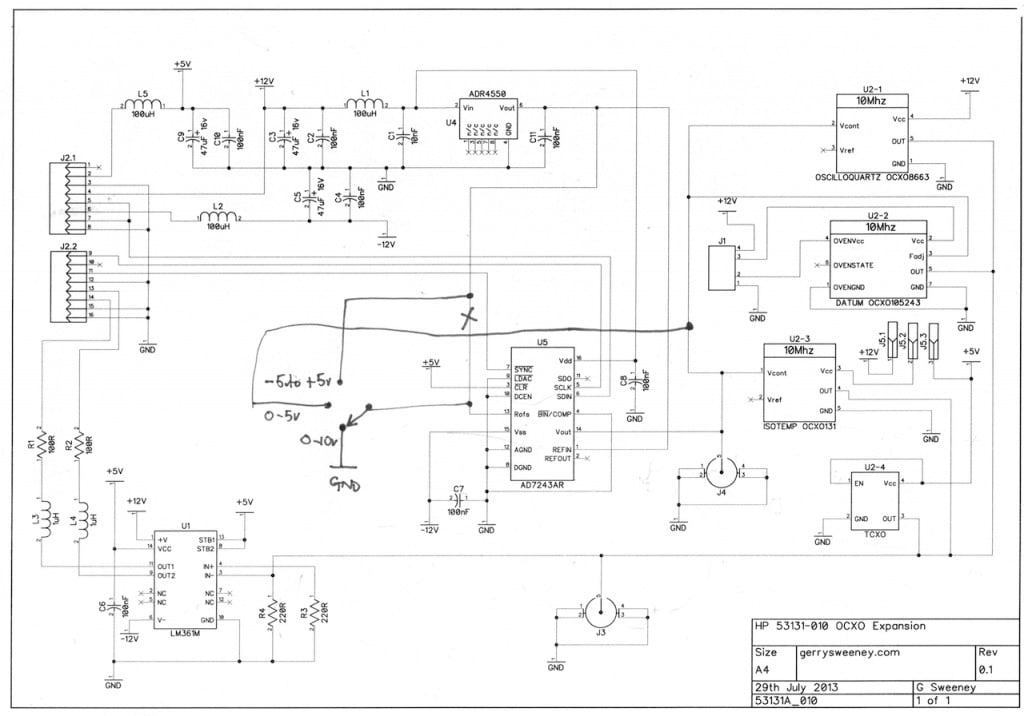
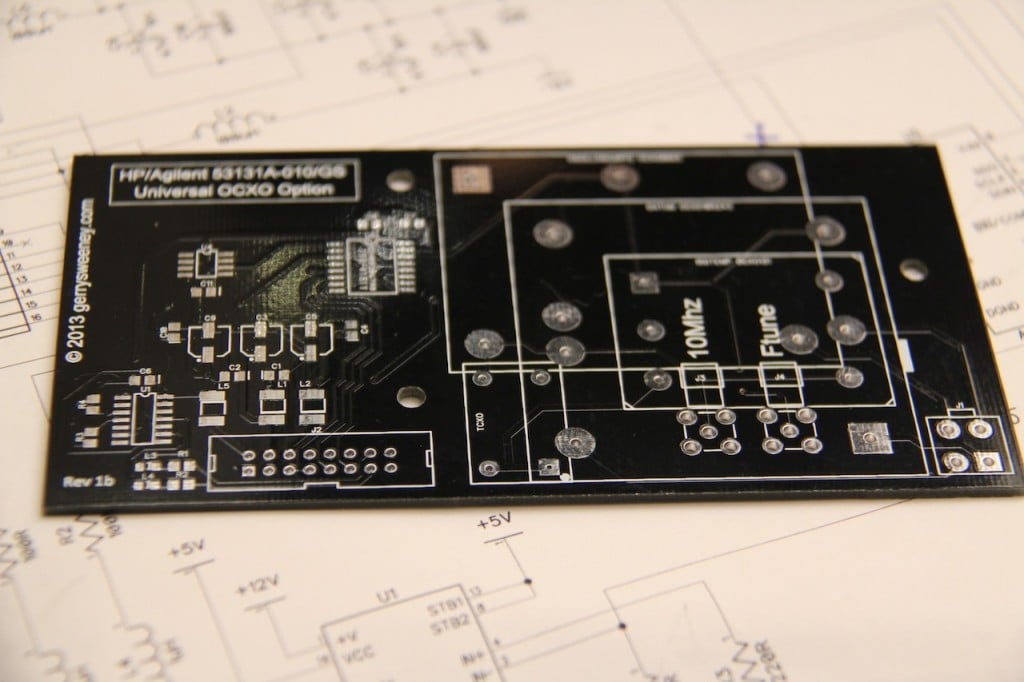
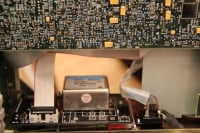
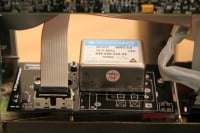
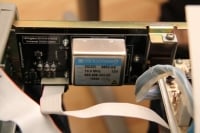
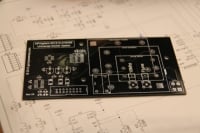

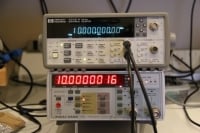
Gerry – Really nice job.
Yes crystals are affected by G , I think it’s mechanical.
You can purchase crystals which are more tolerant of this effect ( for more money of course ).
Of course you wouldn’t normally notice this effect – but because you now have such stable frequency sources you can start to see these things.
So – you said you wouldn’t get the timenuts bug ? Care to rethink that 🙂
Andy,
Haha, well I think I probably have enough time-domain accuracy now, I am not going to take it any further. The RFS is absolutely great, warms up in a couple of minutes and ready to use. The OCXO in the counter is really excellent, gets basically up to operating temperature in about 15 minutes, 60 minutes and its rock solid stable. Finally the HP counter delivers what it should have done from day one!
I just built and tested your board, works really nicely, I made a short vid, will send you the link
Gerry
Gerry,
Thanks for sharing this project. I have a 181a (that I just received) and love to see this video and info.
I really appreciate If you cold sell this pcb. Please let me know!
Kind Regards
Hi Rob,
Thanks for the feedback. I am probably going to get some PCB’s made, the cost will depend on how many people want one, I will make a note and let you know.
Gerry
Hi Gerry, I would be interested in any pcb and/or special parts you decide to offer as a “partial kit”. Jim Robbins, N1JR
Jim, ok thanks, I will let you know once I have numbers. Gerry
Hi Gerry.
Nice job with 53131A !
I would be also interested in buying pcb for OCXO.
Is the OCXO pinout compatible with Trimble 34310 or similar ?
Please let me know the price.
nice regards
Pawel, SQ5ESM
Hi Pawel, I have just updated the board to include a footprint to handle the Trimble 34310 footprint, it was a squeeze but its in there now. Gerry
Another Jim interested in a pcb/kit….
JimT
OK, thanks
I’m also interested in a pcb or kit.
M.
OK, thank you
Gerry,
Crystals affected by gravity, I would have said cobblers but once the reference is accurate enough
you can actually see this sort of thing…
Span, there is a document referenced in one of these comments from IanJohnson, the document explains it reasonably well. Gerry
Hi Gerry,
That’s a great project, thanks for sharing it.
If you do get some PCBs made I’d certainly be interested in four blank boards.
Nigel, GM8PZR
Hi Nigel,
Thanks for your comments, I will let you know once I know how many would like boards.
Gerry
Count me in.
Will do Patrick, thanks. Gerry
Who is interested making in the Option PCB 010 and 030?
You could make more of the PCB …
The cost on ebay is high, the option 030 on ebay cost more than 200 pounds (I think that the cost of making PCB do not exceed 50 pounds)
Option 010 on eBay in general is not available.
I suggest asking questions on email.
Marcin
Hi Gerry,
Love your videos, please keep up the great work! I’ve got a second hand 53132A, which I assume uses the same ocxo board. If compatible I’d sure love to buy one of your PCBs or complete boards if you decide to sell a few!
Take good care by friend.
Sure, will let you know. Thanks for the comments
Hi Gerry,
I’m interested in 1x OCXO PCB + 1x Option 03 PCB.
Kind regards,
Pedro Couto
Hi Pedro, thanks for the comment/interest. Gerry
HP 53132a I have two for sale
One brand new the other is in
perfect condition.
If interested or can point me in
the right direction please let
Me know (706) 508-5378
Hi, I have quite a few of them myself already. I would list on ebay, I expect they should sell there ok
Gerry
I’m interested as well. I was going to build my own (have the dac) but if you’re making up some boards I’d be interested depending on the price.
HI Greg, thanks for your interest, I will let you know soon. Gerry
Hi Gerry.
I have an Agilent 53131 and have made a 3Ghz ch3 scaler loosely based on your vid. many thanks for the idea. Works better than expected, goes up to about 4.1Ghz. I am now looking at the idea of putting a Hittite 10Ghz div by 2 in front of the mc12079 (in div 64 mode) to get a 6-7Ghz scaler. I have done some tests to see if the 53131 input will handle the 54Mhz scaler output and at least mine is OK up to about 59Mhz. Have laid out a PCB and ordered the hmc361, will let you know how it goes. I would like to buy one of your OCXO boards if you get some made soon.
Many thanks for your very interesting vids.
John (G8BXH)
Hi John,
Thanks for the feedback. That sounds like a nice expansion on the theme. Agilent make a 12Ghz option, and if I am not mistaken a 24Ghz option too. Not sure how you tell the firmware which option is which but I know its possible. Problem is I have nothing that generates signals at those frequencies and no need to work with the same so going beyond the 3Ghz option for me would probably not be so useful. Will let you know about the boards once I have them.
Gerry
I did see mention from someone else that the 12Ghz option performs divide by 512.
So – best to ensure you do a test before ordering the Hittite.
Gerry – perhaps an addition to the 3Ghz option would be configurable ID pins.
Also – just be aware that the 53131 has an onboard link to supply 5V to the 3Ghz option board ( not installed on my unit ). But if the link *is* installed – and you built the 3Ghz option according to the HP schematics – you would short the counter 5V. I do wonder if the 5V link is installed when you order the counter with the factory 12Ghz option.
Hi Andy,
When I installed the 3Ghz option into my counter I did not mess with any links. Which link is it? I will take a look. As for the 12Ghz I presume the layout would be different, I presume its not just a case of different MMIC’s and prescaller IC?
Gerry
The prescaler option boards tie certain ID pins high or low to indicate which option is installed. So – the identity is determined by the installed board ( logical ) – what I’m suggesting is that if you made the prescaler board have an adjustable personality – you could add an outboard higher frequency prescaler ( to extend the range to 12Ghz or 24Ghz ). I don’t think it’s advisable going beyond 3Ghz with plain old FR4 pcbs. At 12Ghz you definately need specialist pcb material ( and that’s outside of the production capabilities of most cheap PCB production facilities ). So – unless you wish to make your 3Ghz board out of the higher spec PCB material – then it seems that it’s better to have the 12Ghz part on another board – or even external. ( For example look at Rogers RO4000/RO4350 laminates ).
Hi Andy,
Oh ok, I see what you are saying now, that makes sense. I will look into the ID pins and see what might be feasible – not sure how easy it would be to make this settable from outside the unit without which it would not be so workable. Food for thought.
Gerry
I would also be interested in one of these boards, depending on cost.
In any case thank you for your excellent video! You have a great blog and all of your videos are well done and helpful.
Thanks for your comments and feedback re the blog, much appreciated. I am not planning to make a living from selling the boards, I expect them to be more than reasonable. Gerry
G’day Gerry,
I just bought (Ebay) a 53132A counter which has a no-name time base. So, I’m eager to build a better ovenized time base and wonder if you have made any decision about offering boards/special parts/kits etc? I have a number of OCXO units (MTI/Navcom/Morion/Oscilloquartz, etc) but would especially love to get a board and/or the AD7243AR, ADR4550 and the connector cable socket. It would be worth a “premium” cost to me to get these items from you as it makes possible something which is not otherwise practical for me (and you should get some sort of legitimate return on your design and parts acquisition time and effort). Hope all is well down under. 73, Jim Robbins, N1JR
Hi Jim,
I have had some boards made, I am just waiting for them to arrive and of course have to test them. As soon as I have them I will make a follow-up video and put out some documentation. Not sure if I can supply other parts too easily, I do have about 50 sets of components needed to make a board but I have not yet worked out what they cost me, I will do that once I have verified the boards and tested some.
Gerry
Gerry, I am interested in two sets of the time base and prescaler pcbs. Great videos I like your approach to solving problems. Thanks, Glenn
OK, great, I will let you know as soon as I have them.
Gerry
Hi Gerry,
I’m interested in one OCXO PCB and/or kit (especially the kit).
I love your videos and hands-on technique. I’ve learned a lot from you. Thanks for all of the enlightenment.
Jon
Thanks Jon, I am expecting the boards back from the fab house next week, once I have done some testing I will put a video out. Thank you for the feedback on the video’s, much appreciated. Gerry
Hi Gerry !
Will you be selling the PCB or you share files to perform the PCB?
Is such action is at all in the plan?
Yes I will be selling the PCB’s and possibly some fully built and ready to install modules – I have some on order, I am expecting them any time now. I need to build a couple up and validate the design before I make them available though. Gerry
G’day Gerry,
I would be very interested in 2 PCB’s with SM parts installed (preferably) or without surface mounted parts. I have several OCXO’s which will work fine on such a board. Will the 53132A counters already have the multi-wire ribbon cable or is that something which I will need to obtain separately? Thanks a lot for your fine work here. A really useful winner! 73, Jim Robbins, N1JR
Hi Jim, I should have enough parts to build about 50 of these boards including OCXO’s and ribbon cable connectors. I have no idea what they will cost, I have not yet costed them. I will also have 50 bare boards which I will make available for sale, assuming they work of course – I have not received them yet, just got a text today, they are hold up in Heathrow so should be early next week. I will post a short video once I have tested and worked out costs. Gerry
And what will be the (approximate) price PCBs, modules (or kits)
Hi, I have not worked out the costs at this point, I will do very soon and will post an update. Gerry
I have one question …
Does anyone have schematics options 050 124?
050 – 5 GHz
124 – 12.4 GHz?
It was interesting to perform the last option
Hi Marcin, I do not have these schematics, would be nice to see, I suspect there is not too much difference, just a different pre-scaler chip and some higher rated MMC’s. Its not something I could even tackle as I don’t have anything that can generate those frequencies 🙁 Gerry
I think so too
If I get guidance – specifications J2 connector, I just can undertake the design of such a module.
It will not be easy (availability of items) but you can take a chance?
Hi Marcin, I am not sure I understand the question? Gerry
otherwise (mistakenly started from the end of the problem ( connected divider to HP) …
I look for the time being, if there are items that can be used to build such a divider.
Unfortunately, the items on the high frequencies are difficult to access.
Retrieving items to 5-6 GHz still possible, but above this frequency is already a problem …
Thanks for the clarification, I understand now, you are going to try and identify the parts that *could* be used to make the 5Ghz/12.5Ghz versions of the pre-scaller board. Gerry
I reviewed several companies: Hittite, avago, agilnet.
Dividers are available (up to 12 – 18 GHz)
Probleme are broadband amplifiers, practically no amplifiers to work linearly from 200 MHz to 12 GHz.
Agilent would presumably ordered a hybrid (or he has done)
Exp
divider HMC363 (/8) DC-12 GHz
HMMC-3108 /8 (DC-16 GHz)
Amp
Avago VMMK-2503 ?
Hi Marcin,
The prescaller looks like it would do, you would feed the output of that into another one to get the right scale. Not sure about the amps, working at 12GHz is well beyond my capability and understanding! Gerry
I know the topic is difficult 🙂
But maybe someone will, and tell something 🙂
But probably try to make this divider based on the HMC363, and VMMK-2503
HMC363 these integrated circuits have
VMMK are in stock at Farnell
no risk no fun 🙂
Thats a fair point, perhaps someone reading these comments would know how to construct such a thing. Those VMMK-2503 are only 1mm x 0.5mm in size! Anyone got a 12.5Ghz sig gen 😛 Gerry
Well, there is a certain barrier …
I have a small (tiny) issue
As we need a divider by128, I used HMC363 chip that gives the division by 8, the need to divide 16 The offer is quite poor.
I only found it NB6L239MNG.
Does anyone know any different?
needs
min max frequency of 2.5 GHz
division by 16
You can use the two systems but want to limit the number of items.
Interested in osc pcb/kit/built and also Chan 3 divider – only need 3GHz
Thanks
Peter
G’day Gerry,
Just wondering if there is any update on the High Stability TB kits/PCBs for the HP/Agilent 53131A/53132A counters? Thanks.
Jim Robbins
N1JR
Hi Jim,
Yes I have some boards now, I need to build a couple of them and make sure they work and fit etc, I will be doing a video the weekend.
Gerry
Hi
This is almost finished…. a schematic diagram of the divider up to 13 GHz.
For now, even without PCB
http://rflab.pl/projekty/DIVIDER12GHZ/DIV12GHZ.htm
I should be grateful for any comments.
Hi Marcin, I am no expert in RF. The design looks workable from what I can tell but do you not need a series resistance for the MMIC’s, I would have thought you need to set up the DC bias conditions with some resistance, even if you need to bypass the resistance for AC to let the inductors do their job. Other than that, PCB layout is going to be critical – I suspect that normal FR4 material will not be good enough either. Good luck with building this, I will be interested in seeing the result. Gerry
Hi Gerry
The external resistor to the DC-bias is not required. At least I think so with datascheet.
http://www.farnell.com/datasheets/622195.pdf
As written on page 6
“The VMMK-2503 is normally biased with a positive drain supply connected to the output pin through an external bias-tee and with bypass capacitors as shown in Figure 19. The recommended drain supply voltage is 5 V and the corresponding drain current is approximately 65mA. The input of the VMMK-2503 is AC coupled and a DC-blocking capacitor is not required. Aspects of the amplifier performance may be improved over a narrower bandwidth by application of additional conjugate, linearity, or low noise (Γopt) matching.”
Of course you can use an external power stabilizer, but I think that for the +5 V supply voltage should current not exceed 70 mA . (I hope so 🙂 )
Of course, you should use a PCB laminate: teflon or ceramic …
question
in my HP does not have holes for this option 🙂 I do not know why?
Can you give me the dimensions and size of the holes in the PCB for assembly? I want to PCBs is consistent with the specification 🙂
So I do not have these important dimensions
Thank you
Hi, the PCB dimensions are defined in a sample hand drawing in this article: http://gerrysweeney.com/diy-hpagilent-53131a-030-3ghz-channel-3-option-board/
Gerry
Hi Gerry,
You made a very nice design of DIY HP/Agilent 53131A 010 High Stability Timebase Option!
Could you sell me a PCB for this project?
Thanks and regards,
Miklos
Hi Mikos, yes I can. I will be putting an update video out the weekend, I have some boards, I just need to test the latest layout. Watch this space. Gerry
G’day Gerry,
Was wondering if there was any progress on the High Stability 53132A/53131A Time Base boards/kits? No pressure; just curious.
73,Jim Robbins, N1JR
Hi Jim,
Just making the video now 🙂 should be live this evening…
Gerry
Do you still have some fully built and tested bd?
Hi Robert,
Yes I still have some, do you need one?
Gerry
Hi Gerry
Yes i need 3 if you have them and also can you tell me the total cost for the 3 and shipping cost to Arizona.
Thanks
Hi Robert,
Sorry for the delayed response, I did not get a notification for some reason, I will fire you an e-mail
Gerry
If you still have have a board I would be interested as well.
Thanks in advance.
Philip
Hi Philip,
Yes I still have some boards available, please feel free to order, I will be unable to ship until the week of the 17th of August though
Gerry
Gerry,
I purchase some of user 010 OPT but the counter does not read via IEEE is there something I’m missing?
Hi Robert,
I am not sure I understand the question, can you expand on it please?
Gerry
The unit through the bus (IEEE) and you send *opt? to the unit it comes back with 001 and not 010.
Hi Robert,
Ah ok, I think I understand now. I am not sure as I have never used the IEEE bus on one of these counters, I will need to look in more detail at the implementation and let you know. I suspect there are some ID bits on the header that need to be tied differently, its not something I considered in the design to be honest. I will post more when I have investigated.
If you have purchased one of these and its not suitable for your purposes for this reason you can return it and I will happily refund you.
Regards,
Gerry
The Agilent 53131A has option 001.
If you are retrofitting option 001 to 010 High Stability Timebase, on the Agilent board is a jumper cap you remove for opt 001 or do not remove for 010 (P1). To identify the unit is equipped with opt 010.
Hi Gerry do you have any boards left? Does it take any OXCO modules that I can buy from Digikey or Mouser? Many thanks.
Hi Alex,
I have bare PCB’s left and ready build and tested boards with very good Trimble OCXO’s installed. Not sure if you can buy any of these from Mouser/Digikey, they will be expensive. The second-hand OCXO’s are very good and relatively low cost in camparison to a new one
Gerry
Hi Gerry the calibration process of the HP53131 is the same for the 53132.
I have a 5312 and I do not take the same menu of your video a greeting Jose Ignacio EA1AWV
Hi Jose,
Yes the calibration procedure is the exact same. However, the menu option is *only* present when you have the High Stability Timebase Option installed.
Gerry
Gerry,
Thanks for selling such a nice product. I installed and calibrated the OXCO in my 53131A and it is working nicely.
I have a very early 53131A with firmware 3335 and your OXCO works perfectly with it. This older firmware has the calibration menu under the RECALL key instead of the typical key held down at power-up but otherwise it behaves the same way. I only mention this since it may help other customers of yours who may be concerned whether or not your board will work well with the very early 53131A instruments. YES it works perfectly.
Best Wishes,
Craig Kirkpatrick
KI7CRA
Hi Craig,
You are welcome, thank you for the kind feedback.
Gerry
Hi Gerry, GOOD job !!! I’ve a simple question : you also know the internal circuit of HP5384A ?
I ask this ‘cose i have this freq. meter, and i must know IF your circuit is ok ALSO for my 5384A …. = then i can buy your pcb !!
Thnk you for your attention & for your work !!!
I am afraid I have never played with one.
Gerry
Hi, I recently bought a pcb from you and built it. It works great. On the board I am using a DOT050V 10 MHz crystal 50ppb with a small adapter with 3.3v regulator and scalling resistors for the control voltage. Good enough for portable work – and no warm up time needed. Calibration works well on my 53131a. I have an lpro-101 for higher precision long term use.
Thanks for your great project!
Thank you for the feedback Mike, glad you found the board useful.
Gerry
Hi Gerry
Do you still sell the DIY timebase PCB?
Hello Hans,
Thanks for your interest, Yes, I still sell them.
Gerry